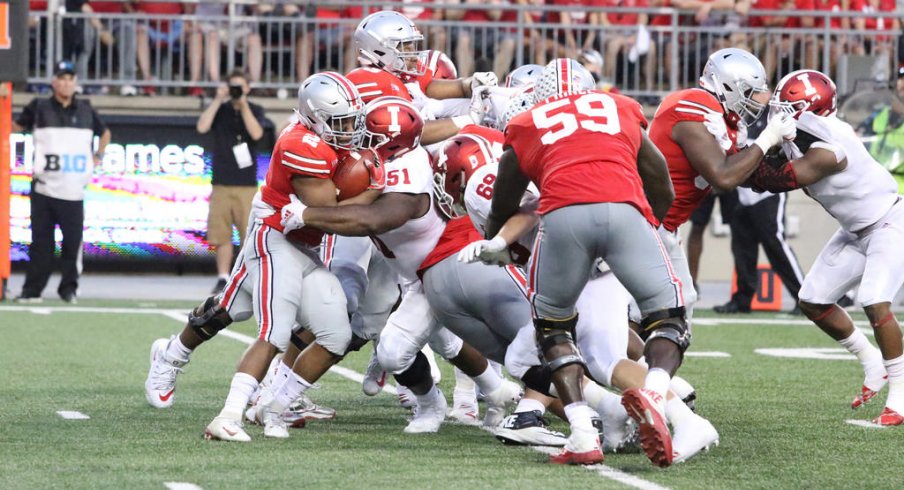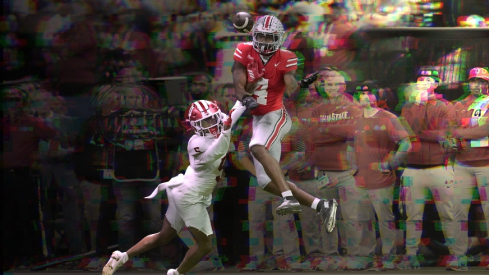"Dwayne would be the first one to tell you. And it’s no different than when the run game’s cooking, the offensive line is the reason why." - Urban Meyer following Ohio State's 49-26 win over Indiana.
Throughout Meyer's tenure as the head coach in Columbus, Ohio State has always featured one of the most dominant running games in the nation. Led by dual-threat quarterbacks that threatened defenses with their legs as much as their arms, the Buckeyes have finished in the top 20 in both yards-per-carry and rushing yards-per-game in every season since Meyer's hiring in 2012.
Despite ranking fifth in the country in total offense midway through the season and featuring two thousand-yard rushers in J.K. Dobbins and Mike Weber this fall, however, the scarlet and gray ground game has been merely average. Their 4.67 ypc is a far cry from the 5.78 we saw last year, despite the new and constant threat of a downfield passing attack with Dwayne Haskins at the helm.
Many have speculated that Haskins' lack of running prowess is the leading factor in this equation, as defenses can focus entirely on his teammates in the backfield. But, as the comeback victory over Penn State last week showed, the threat of a bubble screen to Parris Campbell or K.J. Hill is just as dangerous, if not more, than J.T. Barrett or Braxton Miller keeping on a zone-read.
'Perhaps the scheme itself is too predictable or simplistic,' you might be thinking. Except Meyer's offense features one of the most diverse run games in the nation, mirroring the complexity of most NFL playbooks, thanks primarily to the efforts of co-coordinator Kevin Wilson. The Buckeyes have already shown a bevy of zone and gap schemes this season, capable of hitting holes both inside and out.
Instead, the Buckeyes simply seem to lack the consistency in execution to which we've grown accustomed over the past half-decade, failing to execute the plays as they're called. This variation in results was on full display last weekend as the Buckeyes surpassed the 40-point barrier for the fifth time already this autumn while racking up over 600 yards of offense, thanks mainly to Haskins' monstrous day throwing the ball.
Dobbins finished the day with a pedestrian 86 yards on 24 carries while Weber was slightly more effective with 72 yards on 13 totes of the rock. As a team, however, the Buckeyes averaged just 3.2 yards-per-carry in their win over Indiana, marking the lowest average rush surrendered by the Hoosiers all season.
Though the Buckeyes have started the same five players consistently up front, the rotation at tight end has continued to be an issue. Neither Luke Farrell or Rashod Berry have performed a level deserving of the starting role, meaning the duo continue to rotate with freshman Jeremy Ruckert finding more playing time.
As seen below, the Buckeyes are running Power, with the backside guard pulling around to create an extra gap along the left edge. OSU called for this play frequently against the Hoosiers, who lined up regularly in odd looks with only three down linemen in an attempt to stymie inside runs.
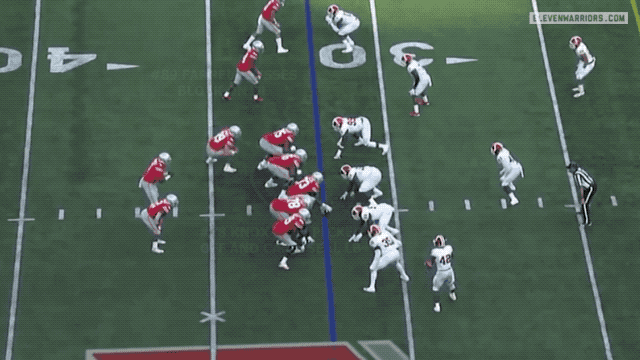
Though Farrell makes good initial contact with the defensive end, he doesn't maintain it, allowing the end to bounce off and close the gap. Not only does this re-route the pulling guard and prevent him from make his block, but it also leaves nowhere for the back to go.
But, when Farrell made way for Ruckert to see a series at tight end, the same problem occurred. This time, the Buckeyes call a simple, tight zone run, asking every blocker to close the gap to their right.
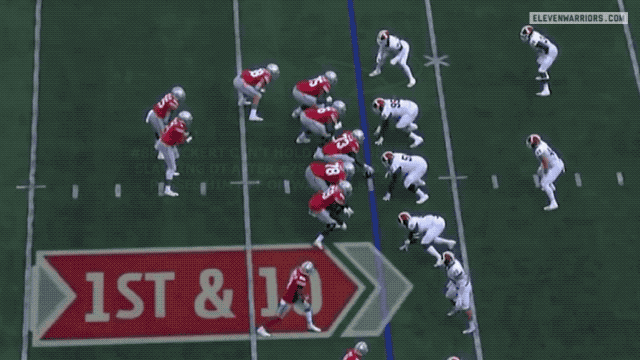
After left tackle Thayer Munford makes initial contact with the slanting defensive end, Ruckert fails to pick him up once Munford recognizes the stunt and looks to move up to take on the linebacker.
As you can also see above, right guard Demetrius Knox gets beaten in a similar fashion, giving up penetration to a slanting end on his side. Individual failures like these appeared all over the place throughout the afternoon, and the unit as a whole struggled to overcome them.
However, it's not as though they were a total failure. On a critical 4th & 1 early in the game, Knox helped create a massive hole by blowing his man directly off the ball, moving the defender well out of the play and creating a seam for Weber.
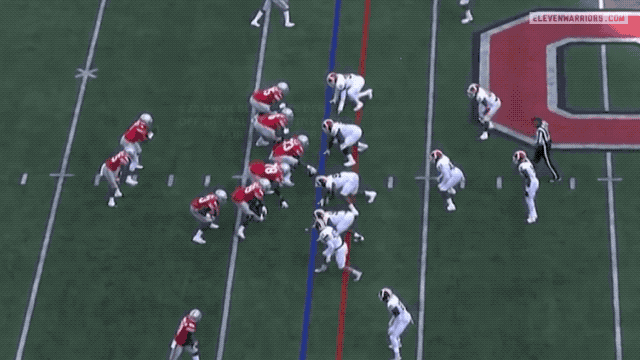
Similarly, the Buckeyes found success by changing up the scheme in the second half. In addition to a consistent diet of five and six-man blitzes, Indiana found success early by slanting and stunting the defensive line, keeping the Buckeyes from getting blockers to the linebackers who then, in turn, were free to make tackles.
One way to counter such an approach is to not block the middle linebacker at all and let the back read him. Such is the idea behind the Duo run concept. Though it looks like a typical tight zone run, the center never looks to get upfield to the MIKE linebacker, leaving the back to hit the gap opposite the one said linebacker fills.
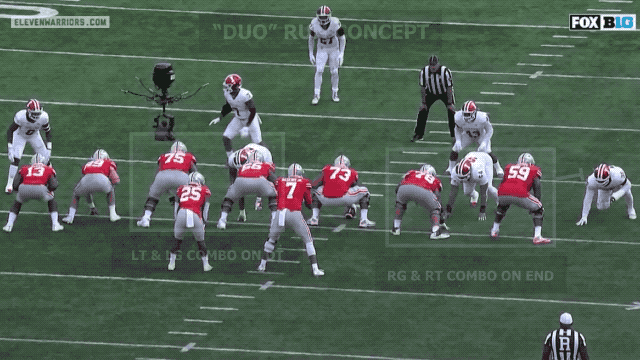
While this concept is less successful with big, powerful backs that only run straight ahead, it's a perfect complement for teams that lean heavily on zone runs and have shifty backs that can change direction on a dime like the Buckeyes.
All these inconsistencies were masked by a passing game that, as mentioned, flourished against Indiana. Haskins came within just a few yards of setting the school record for passing yards in a single game, throwing six touchdowns in the process.
But as anyone who watched the game knows, those touchdowns were marred by a pair of costly interceptions that came as the quarterback was hit while throwing. The first came on a well-designed, delayed blitz that came from the far hash.
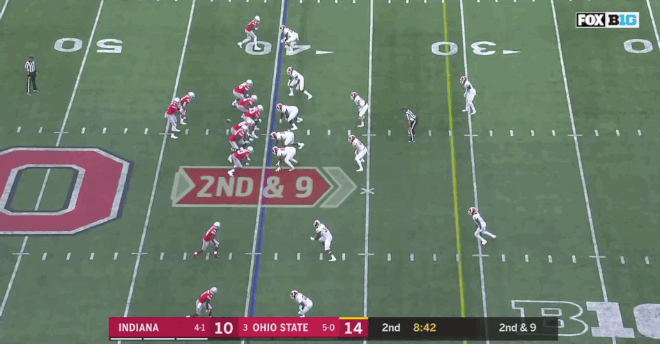
As the right tackle Isaiah Prince works with Knox to handle a stunt to their side, they don't see the late-arriving blitzer. Though Haskins tries to step up in the pocket, the downfield play left him with no options to get rid of the ball right away as he waited for the crossing route to finally spring open. By the time he could throw, the defender had already arrived.
Haskins' second interception came due to another error up front. This time, the Hoosiers don't bring any additional rushers and only twist the interior tackles, creating pressure that should easily be handled by the Buckeyes' front five.

But Munford gets beat on an inside spin move that Haskins doesn't expect, allowing the ball to float out of his hand and directly into those of a Hoosier defensive back as he's hit.
Though these two failures in protection may have been the headline for many fans, the OSU pass protection was largely successful otherwise. While the Hoosiers continued to blitz consistently throughout the game, the Buckeyes only gave up one sack on the afternoon, allowing Haskins the time to distribute the ball to his athletic receiving crew.
"They were sending in some different types of blitzes. We wanted to get the ball out of Dwayne’s hands a little quicker," wide receiver Terry McLaurin told reporters afterward. "We had a good game plan coming in. We hit a lot of the routes we practiced all week against the coverages we wanted to see. We did a good job adjusting on the fly even after two tough picks."
Those coverages were often three-deep, three-under zones that left plenty of open grass underneath, freeing up the same Mesh concept that tore up the Hoosiers in Bloomington the year prior.
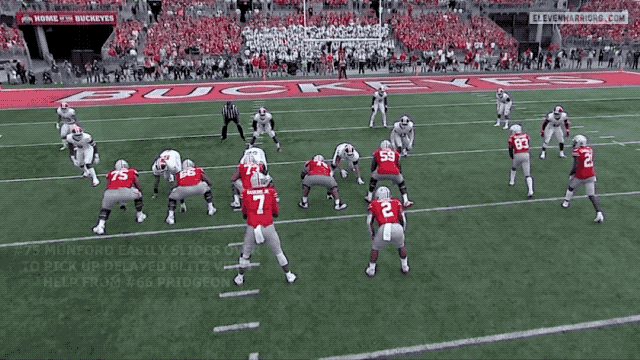
Though they struggled to handle pressure in the run game, the offensive line handled the barrage of blitzes well when protecting the passer, successfully passing off oncoming rushers to one another with seeming ease. Perhaps no example showed this execution finer than Haskins' final touchdown toss of the evening, a 30-yard strike to Binjimen Victor down the sideline.
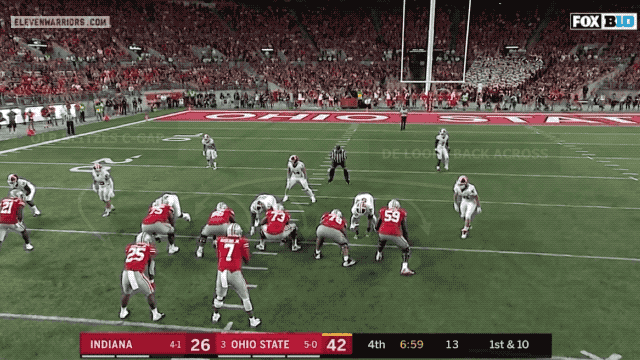
The Hoosiers brought five rushers on the play, looking to loop an end around to the opposite side following an initial blitz from the outside linebacker. With the help of Weber, who picked up the blitz easily in this six-man protection scheme, Haskins had a perfectly clean pocket from which to throw.
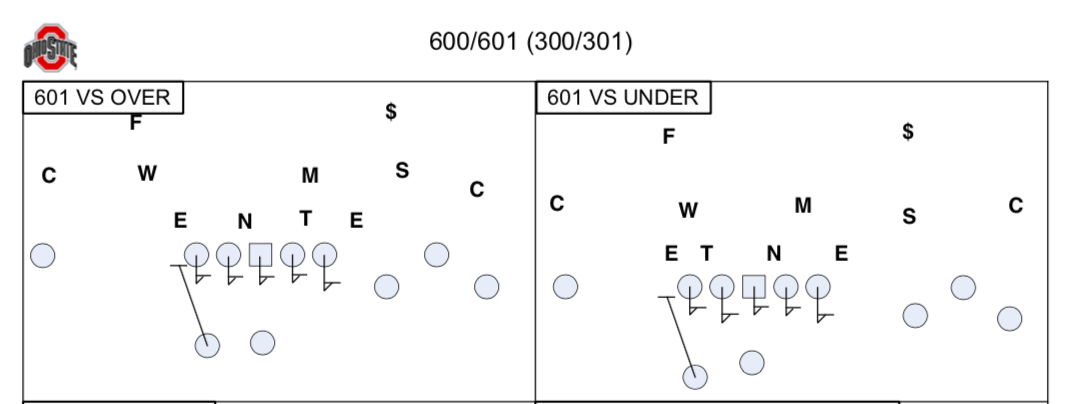
While an offense that can shower down pass after pass may be more aesthetically pleasing than the one that grinds opponents into dust through an efficient running game, the reality is at some point, the Buckeyes must find more consistency on the ground if they hope to achieve their championship dreams.
Though the Buckeyes have passed some stiff tests in the form of TCU and Penn State, the Hoosiers may have left a blueprint for other stout run defenses like Minnesota, Michigan State, and Michigan to follow with an onslaught of slants, twists, and blitzes, making Urban Meyer's offense one-dimensional. Just probably not in the way many of us expected.
